In the dynamic landscape of education, fostering an engaging learning environment is paramount. Fun geology activities for kids that play a pivotal role in transforming the study of Earth’s processes into an enjoyable and immersive experience for students. By integrating hands-on and imaginative approaches, these activities not only enhance comprehension but also ignite a passion for geological exploration, making the learning journey both captivating and memorable.
Table of contents
- Why Earth Science Matters
- The Importance of Nurturing a Love for Science
- Creative Geology Activities Overview
- Activity 1: Rock Painting Expedition
- Activity 2: Fossil Excavation Adventure
- Activity 3: Earth Science Scavenger Hunt
- Transforming Learning into Play
- Tips for Parents and Educators
- Conclusion
- Frequently Asked Questions
Why Earth Science Matters
In the vast cosmic tapestry of the universe, Earth holds a unique position as the cradle of life. Understanding the intricate workings of our planet is not merely an intellectual pursuit; it is a vital endeavor that holds profound implications for our existence. Earth science, encompassing disciplines like geology, meteorology, oceanography, and more, serves as a key to unlocking the mysteries of our home.
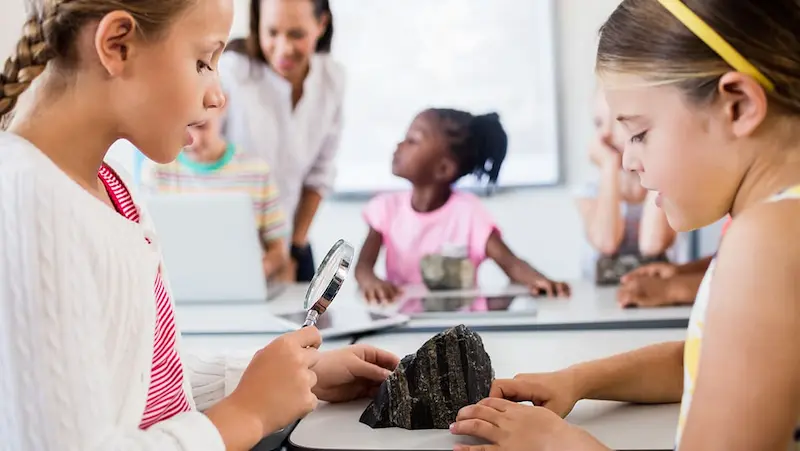
Understanding Our Planet
Earth science is the lens through which we gain insights into the dynamic processes shaping our planet. From the majestic peaks to the deepest ocean trenches, geologists study the Earth’s composition, structure, and history. By deciphering the layers of rocks, they can unravel the story of Earth’s evolution over millions of years. This knowledge not only satisfies our curiosity about the past but also provides critical information for predicting and mitigating geological hazards such as earthquakes and volcanic eruptions.
Real-World Applications of Geology:
1. Natural Resource Exploration: Geology plays a pivotal role in locating and extracting valuable natural resources like minerals, oil, and natural gas. Through geological surveys and mapping, scientists can identify areas with high potential for resource deposits, aiding in sustainable resource management.
2. Environmental Assessment: Geologists contribute to environmental conservation by assessing the impact of human activities on the Earth. From monitoring soil quality to studying groundwater flow, geology helps us understand the consequences of industrial processes and urbanization on ecosystems.
3. Hazard Mitigation: Earthquakes, landslides, and volcanic eruptions pose significant threats to communities worldwide. Geologists analyze seismic activity, study fault lines, and monitor volcanic hotspots to develop early warning systems and strategies for minimizing the impact of these natural disasters.
4. Climate Change Studies: As the global community grapples with the effects of climate change, Earth scientists, including climatologists and oceanographers, play a crucial role. By studying atmospheric patterns, ocean currents, and climate indicators, they contribute valuable data to our understanding of climate change, guiding efforts to mitigate its impacts.
5. Infrastructure Development: Before constructing buildings, bridges, or dams, geotechnical engineers rely on geological data to assess the stability of the ground. Understanding soil composition and potential geological hazards is essential for designing resilient infrastructure that can withstand the forces of nature.
The Importance of Nurturing a Love for Science
In a world shaped by technological advancements and scientific breakthroughs, fostering a passion for science in young learners is more critical than ever. Beyond the confines of school curricula, nurturing a love for science in children has far-reaching benefits that extend into their academic, personal, and professional lives. One specific branch of science, geology, provides a fascinating gateway to ignite curiosity and interest in young minds.
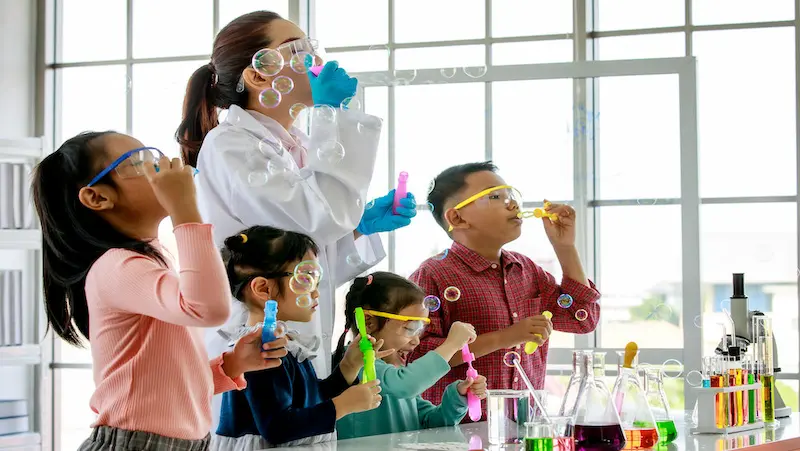
Benefits of Fostering a Passion for Science:
Critical Thinking Skills: Cultivating a love for science from an early age enhances critical thinking skills. Science encourages children to question, observe, and analyze the world around them. This process of inquiry and exploration lays the foundation for developing strong analytical and problem-solving skills.
Curiosity and Creativity: Science is driven by curiosity and a desire to understand the unknown. Nurturing a love for science sparks creativity and imagination in young minds. Children become natural explorers, eager to uncover the mysteries of the universe and develop a lifelong love for learning.
Real-world Application: Science is not confined to the pages of a textbook; it is a dynamic force that shapes the world we live in. Fostering a passion for science helps children connect theoretical knowledge to real-world applications, fostering a deeper understanding of how scientific principles impact everyday life.
Preparation for the Future: As the world becomes increasingly reliant on technology and scientific advancements, individuals with a strong foundation in science are better equipped to navigate and contribute to a rapidly evolving society. A love for science opens doors to future careers in STEM fields, ensuring that young learners are well-prepared for the challenges of tomorrow.
Early Exposure to Geology: A Gateway to Curiosity:
Geology, the study of the Earth’s structure, composition, and processes, serves as an excellent entry point for fostering a love for science in young minds. Here’s how early exposure to geology can spark curiosity and interest:
Tangible and Observable: Geology offers tangible and observable phenomena, making it accessible and engaging for young learners. From collecting rocks to studying the layers of the earth, children can physically interact with geological concepts, enhancing their understanding and interest.
Connection to Nature: Geology provides a direct connection to the natural world. Exploring rocks, fossils, and landscapes allows children to appreciate the Earth’s beauty and diversity. This hands-on experience fosters a sense of wonder and encourages a lifelong appreciation for the environment.
History Unearthed: Geology unveils the Earth’s rich history through the study of fossils and rock formations. Learning about the planet’s past stimulates curiosity about evolution, climate change, and the interconnectedness of Earth’s systems, laying the groundwork for a broader understanding of science.
Problem-solving Opportunities: Geology presents numerous problem-solving opportunities. Studying geological phenomena such as erosion, earthquakes, and volcanoes invites young minds to explore solutions and understand the importance of addressing environmental challenges.
Creative Geology Activities Overview
Geology, the study of the Earth’s structure, processes, and history, can be a fascinating subject for learners of all ages. However, traditional methods of teaching often fail to capture the imagination and enthusiasm of students. To bridge this gap, educators and enthusiasts alike have turned to creative geology activities that not only impart knowledge but also transform the learning experience into play.
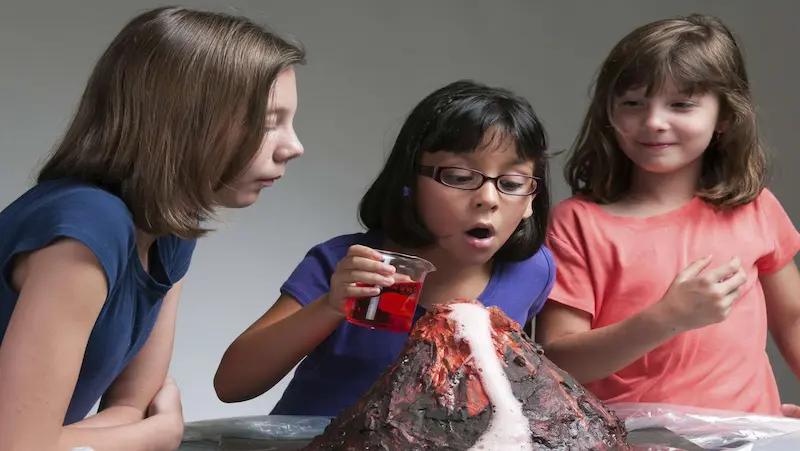
Overview of Creative Geology Activities:
Rock Painting and Identification:
- Turn ordinary rocks into vibrant canvases by encouraging participants to paint geological formations or landscapes on them.
- The process of identifying and painting rocks helps participants develop observational skills while fostering creativity.
Fossil Excavation Simulation:
- Create a mock fossil excavation site using sand, plaster, and hidden “fossils” (plastic replicas or homemade imitations).
- Participants can experience the thrill of a paleontological dig, fostering a sense of discovery and curiosity about Earth’s ancient inhabitants.
Geo-Treasure Hunt:
- Develop a treasure hunt where participants follow clues to find geological specimens or artifacts.
- This activity combines problem-solving, teamwork, and geology knowledge in a dynamic and enjoyable way.
Volcano Modeling:
- Craft miniature volcanoes using household items like baking soda, vinegar, and clay.
- Participants can witness the eruption process, gaining a hands-on understanding of volcanic activity and its impact on the Earth’s surface.
Mineral Crystal Growing:
- Explore the fascinating world of mineralogy by growing crystals at home.
- This activity not only teaches the basics of crystal formation but also provides an opportunity to discuss the importance of minerals in various industries.
Sedimentary Layers Snack:
- Create edible representations of sedimentary rock layers using different types of snacks.
- This tasty activity allows participants to understand the concept of rock formation while indulging in a delicious treat.
Transforming Learning into Play:
The incorporation of these creative geology activities can significantly transform the learning experience into a playful and memorable adventure. Here’s how:
Hands-On Exploration:
By engaging in activities like rock painting, fossil excavation, and volcano modeling, participants actively explore geological concepts through hands-on experiences, enhancing retention and understanding..
Activity 1: Rock Painting Expedition
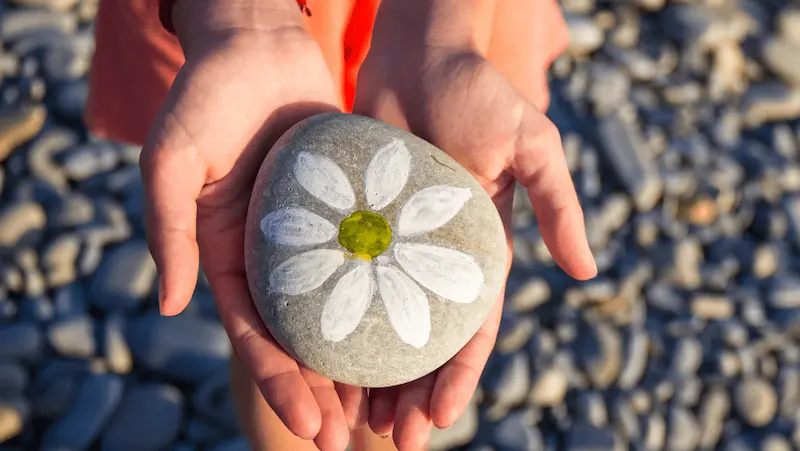
Objective:
Encourage creativity, foster artistic expression, and connect with nature through a rock painting expedition. This activity not only serves as a fun and engaging experience but also provides an opportunity for learning about different rock types, geological formations, and the significance of art in various cultures.
Materials Needed:
- Smooth and clean rocks (collected beforehand or provided)
- Acrylic paints in various colors
- Paintbrushes in different sizes
- Water cups for cleaning brushes
- Paper plates for mixing colors
- Aprons or old shirts to protect clothing
- Clear sealant spray (optional)
- Educational materials about rocks and their formations (books, printouts, or a brief presentation)
Step-by-Step Instructions:
1. Introduction to Rocks: Begin the activity with a short introduction to rocks. Discuss the different types of rocks, their formations, and where they can be found. Show pictures or samples if available. Explain that rocks have been used throughout history as canvases for art in various cultures.
2. Rock Collection: If possible, let the participants explore and collect rocks from a designated area. Alternatively, provide pre-collected rocks. Discuss the different shapes, sizes, and textures of the rocks.
3. Setting up the Painting Station: Arrange the painting materials on a table. Ensure each participant has their set of rocks, paints, brushes, and water cups. Provide a brief demonstration on how to use the materials and encourage creativity.
4. Painting Session:
- Ask participants to choose a rock and think about a design or pattern they would like to paint. Emphasize that there are no right or wrong ways to paint a rock.
- Encourage them to incorporate what they’ve learned about rocks into their designs. For example, they could paint rock layers, fossils, or representations of different minerals.
- Walk around, offer guidance, and share interesting facts about rocks during the painting session.
5. Educational Break: Pause the painting session for a brief discussion about the rocks and their artistic expressions. Share information about the rocks’ geological significance, historical use in art, and the cultural importance of rock paintings.
6. Finishing Touches:
- Allow the painted rocks to dry.
- Optionally, apply a clear sealant spray to protect the artwork and give the rocks a glossy finish.
7. Show and Tell: Conclude the activity with a “Show and Tell” session where participants can proudly display their painted rocks. Encourage them to share their inspirations and what they’ve learned during the expedition.
Educational Takeaways:
- Geology: Understanding different rock types, formations, and textures.
- Art History: Exploring the historical significance of rock paintings in various cultures.
- Creativity: Encouraging imaginative and artistic expression.
- Environmental Awareness: Promoting appreciation for nature and its resources.
By combining creativity with education, the Rock Painting Expedition becomes an enjoyable and enlightening experience for participants of all ages.
Activity 2: Fossil Excavation Adventure
In the realm of geology, where rocks whisper tales of Earth’s ancient history, there lies a thrilling adventure that beckons curious minds and aspiring paleontologists alike – Fossil Excavation. Activity 2 in our geology series takes students on a journey back in time, as they unearth hidden treasures buried beneath the Earth’s surface. This hands-on experience not only fosters engagement but also deepens understanding and appreciation for the science of paleontology.
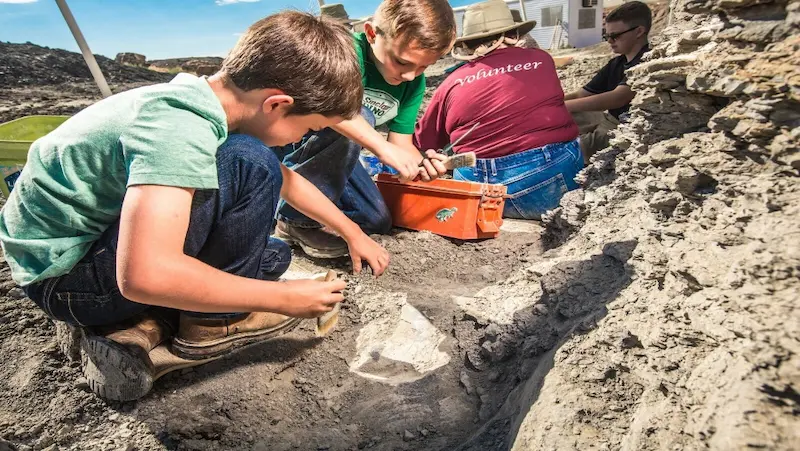
The Fossil Excavation Adventure:
The Fossil Excavation Adventure is an immersive experience designed to bring geology to life. Students are transported to a simulated archaeological site where they become paleontologists for the day. Equipped with tools such as brushes, picks, and shovels, they embark on the exciting journey of unearthing fossils.
The activity begins with a brief introduction to the geological history of the chosen site, providing context for the fossils they are about to discover. Participants then work in teams, carefully excavating the designated area to reveal hidden fossils. The thrill of uncovering a prehistoric specimen beneath the layers of sediment is both exhilarating and educational.
To enhance engagement, incorporate elements of competition or collaboration. Set challenges such as identifying the most fossils or reconstructing a complete skeleton. This not only makes the activity more exciting but also encourages teamwork and critical thinking.
Safety Precautions and Tips:
1. Protective Gear: Prioritize safety by ensuring all participants wear appropriate protective gear. This includes gloves to protect hands from sharp edges and dust masks to prevent inhalation of airborne particles.
2. Supervision: Have experienced supervisors or instructors present to guide and monitor the excavation process. This ensures that safety protocols are followed, and any potential risks are promptly addressed.
3. Tools and Techniques: Provide proper training on the correct use of excavation tools. Emphasize the importance of gentle brushing and careful digging to avoid damaging delicate fossils. Remind participants to report any significant finds to the supervising instructor.
4. Weather Considerations: Be mindful of weather conditions, especially if the activity takes place outdoors. Extreme heat, rain, or strong winds can pose risks, so it’s crucial to reschedule or adapt the activity accordingly.
5. Site Assessment: Prior to the activity, conduct a thorough site assessment to identify any potential hazards, such as uneven terrain or hidden obstacles. Clearly mark safe zones and establish emergency procedures.
Activity 3: Earth Science Scavenger Hunt
In the dynamic realm of education, fostering interactive learning experiences is key to captivating students’ interest and promoting a deeper understanding of subjects. The Earth Science Scavenger Hunt, our third creative activity, emerges as an engaging exploration that not only transforms learning into an adventure but also instills a profound appreciation for the wonders of our planet.

The Earth Science Scavenger Hunt: An Interactive Learning Odyssey
The Earth Science Scavenger Hunt serves as a unique approach to delve into the captivating world of geology, meteorology, and environmental science. This activity encourages students to step out of the traditional classroom setting and explore the immediate environment for clues and information related to Earth’s dynamic processes.
Participants are provided with a list of items, questions, or tasks that prompt them to observe, analyze, and interpret various elements of Earth science. From identifying different types of rocks to understanding weather patterns, the scavenger hunt creates an interactive learning experience that goes beyond textbooks.
Variations for Different Age Groups:
Adapting the Earth Science Scavenger Hunt for different age groups ensures that the activity is both challenging and age-appropriate. Here are variations tailored to various educational levels:
Elementary School (Grades K-5): For younger students, simplify the questions and tasks to match their comprehension level. Consider incorporating visual aids, such as pictures or diagrams, to make the scavenger hunt more accessible. Focus on basic Earth science concepts, such as identifying different types of clouds, rocks, or plants.
Middle School (Grades 6-8): Middle school students can handle more complex concepts. Include questions that delve into the geological processes that shape the Earth’s surface, like erosion and plate tectonics. Introduce tasks that require students to measure and record environmental data, fostering a sense of scientific inquiry.
High School (Grades 9-12): Challenge high school students with advanced tasks that delve into specific Earth science disciplines. Have them explore topics such as climate change, environmental sustainability, or geological formations in more depth. Encourage critical thinking by asking students to analyze the impact of human activities on the environment.
Incorporating Technology:
Incorporating technology into the Earth Science Scavenger Hunt can enhance the learning experience. Utilize smartphones or tablets to document findings through photos or videos. Encourage students to use online resources or apps to research and cross-reference information, fostering digital literacy skills.
Transforming Learning into Play
Education has come a long way from traditional chalk-and-board methods to more innovative and engaging approaches. One such transformation that has gained significant attention is the incorporation of play into the learning process. This shift from conventional teaching methods to a more interactive and enjoyable educational experience is not just about making lessons fun; it’s about harnessing the pedagogical benefits of play-based learning.

Pedagogical Benefits of Play-Based Learning:
Enhanced Engagement and Motivation: Play naturally captures the attention and interest of learners. When educational content is presented in the form of games, simulations, or interactive activities, students are more likely to be engaged and motivated to participate actively in the learning process. This heightened engagement can lead to better retention of information.
Development of Critical Skills: Play-based learning goes beyond traditional rote memorization. It encourages the development of critical skills such as problem-solving, creativity, collaboration, and critical thinking. Educational games often require students to think strategically, analyze situations, and make decisions – skills that are invaluable in real-world scenarios.
Emotional and Social Development: Play provides a platform for emotional and social development. Collaborative games and group activities foster communication, teamwork, and the ability to understand different perspectives. These social skills are crucial not only for academic success but also for personal and professional growth.
Intrinsic Motivation and Autonomy: Play allows learners to explore topics at their own pace, fostering a sense of autonomy. When students feel in control of their learning experience, they are more likely to be intrinsically motivated to succeed. This intrinsic motivation can lead to a deeper and more meaningful understanding of the subject matter.
Bridging the Gap Between Education and Entertainment:
Creating an Enjoyable Learning Experience: By incorporating play into education, the learning experience becomes enjoyable and memorable. Students are more likely to retain information when they associate it with positive emotions and fun experiences. This transformation turns the classroom into a place where curiosity and excitement thrive.
Utilizing Technology for Interactive Learning: The integration of technology in education has opened new avenues for interactive and entertaining learning experiences. Educational apps, virtual reality simulations, and online games are examples of how technology can turn learning into a captivating adventure. These tools not only make learning more enjoyable but also align with the digital preferences of today’s tech-savvy generation.
Encouraging Lifelong Learning: When learning is transformed into play, it creates a positive attitude towards education that extends beyond the classroom. Students are more likely to develop a love for learning and continue seeking knowledge throughout their lives. This lifelong learning approach is essential in our rapidly evolving world where continuous adaptation and upskilling are crucial.
Tips for Parents and Educators
In the ever-evolving landscape of education, parents and educators play pivotal roles in shaping the future of young minds. Creating a supportive learning environment is crucial for fostering a love for learning and ensuring a child’s holistic development. In this blog, we’ll explore practical tips for parents and educators to implement activities effectively and contribute to the growth of children.
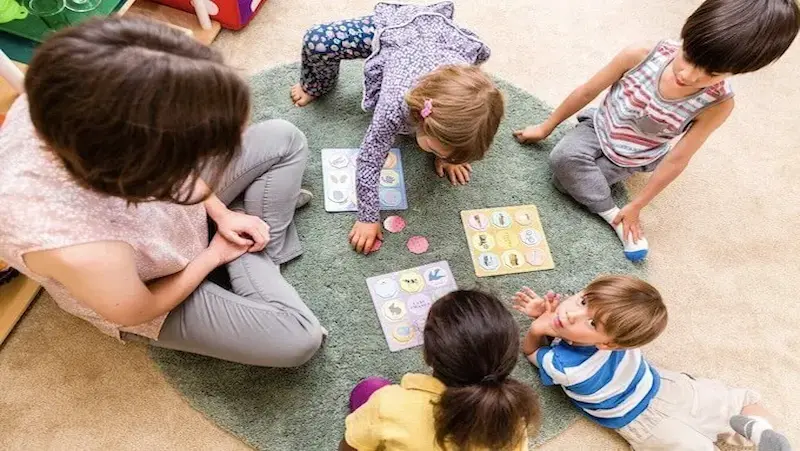
Encourage Curiosity and Exploration:
For Parents: Create a home environment that stimulates curiosity. Provide access to books, educational games, and hands-on activities. Foster open communication by answering questions and engaging in discussions.
For Educators: Design lessons that encourage curiosity and critical thinking. Incorporate interactive activities, experiments, and real-world examples to make learning engaging and relevant.
Establish a Consistent Routine:
For Parents: Set a daily routine that includes designated study time, playtime, and relaxation. Consistency helps children feel secure and understand expectations.
For Educators: Establish a classroom routine that balances academic activities, breaks, and interactive sessions. Clear expectations and consistent routines contribute to a positive learning environment.
Promote Collaboration and Communication:
For Parents: Encourage teamwork and communication skills through group activities and family projects. Create an environment where children feel comfortable expressing their thoughts and ideas.
For Educators: Foster a collaborative classroom by incorporating group projects, discussions, and peer-to-peer learning. Promote effective communication through regular class meetings and open-door policies.
Use Technology Wisely:
For Parents: Embrace educational apps and online resources that align with your child’s learning needs. Monitor screen time and ensure a healthy balance between digital and offline activities.
For Educators: Integrate technology into lessons to enhance engagement and provide a diverse learning experience. Offer guidance on responsible technology use and teach digital literacy skills.
Celebrate Progress, Not Just Perfection:
For Parents: Recognize and celebrate your child’s efforts and progress. Encourage a growth mindset by emphasizing the importance of learning from mistakes and embracing challenges.
For Educators: Provide constructive feedback that focuses on improvement rather than solely on grades. Create a classroom culture that values effort, resilience, and continuous learning.
Create a Safe and Inclusive Environment:
For Parents: Foster an inclusive home environment that embraces diversity. Encourage empathy and teach children the importance of respecting differences.
For Educators: Establish a safe and inclusive classroom where every student feels valued. Incorporate diverse perspectives into lessons and address any instances of discrimination promptly.
Conclusion
In conclusion, this article highlights the importance of nurturing a passion for Earth science, emphasizing that the journey can be both educational and enjoyable. The key points discussed underscore the significance of fostering curiosity about our planet, ultimately contributing to a more informed and engaged society. By combining education with enjoyment, we can inspire a new generation to appreciate and actively care for the Earth.
To get your hands on more such articles, educational content, and free resources on coding classes for kids, online robotics classes for kids, game development, etc., check out the BrightCHAMPS Page now!
Frequently Asked Questions
A1. These activities are tailored for kids aged 5 to 12, but many can be adapted for younger or older children with a bit of modification.
A2. Absolutely! Most materials can be found at home or purchased inexpensively at local stores. Think rocks, magnifying glasses, or simple tools for excavation.
A3. Yes, these activities are flexible and can be adapted to various outdoor environments, such as parks, beaches, or even your backyard.
A4.Definitely! They’re designed to introduce kids to the fascinating world of geology in a fun, hands-on way, fostering curiosity about rocks, fossils, and the Earth’s processes.
A5. Not at all! These activities are designed for beginners, providing simple and engaging ways to introduce basic geological concepts without any prior knowledge required.


 We are an army of educators and passionate learners from BrightChamps family, committed to providing free learning resources to kids, parents & students.
We are an army of educators and passionate learners from BrightChamps family, committed to providing free learning resources to kids, parents & students.








